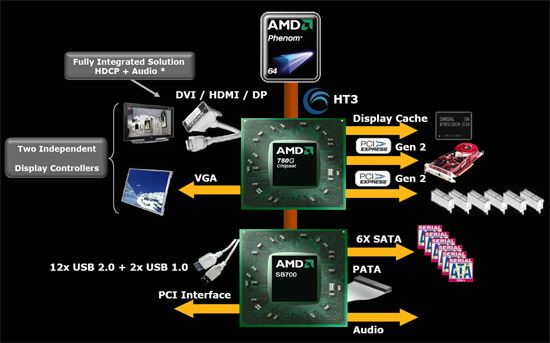ATI 'Hybrid Graphics' is a system which enables a stand alone
Radeon PCI Express videocard to share the 3D processing load with
the AMD 780G integrated graphics chipset in a specialized 'Hybrid CrossFireX' mode.
It allows casual gamers a cheap way
to get a little more gaming performance from what is otherwise a
mainstream PC platform like the ECS A780GM-A. The system only works
with Radeon HD 2400/3400 series videocards and the AMD 780G, if the PC
is running Windows Vista. WindowsXP doesn't support Hybrid Graphics
GPU-teaming, instead the videocard and IGP would operate
independently.

The system is intended to improve mainstream gaming
performance, but clearly two entry level GPUs do not equal flagship 3D
graphics performance. In essence, Hybrid Graphics translates
into a moderate improvement over the typically lackluster 3D framerates an
integrated graphics chipset is capable of. If the Intel G35 Express is the
equivalent of a horse and cart, the AMD 780G with Hybrid Graphics enabled is
more like a buggy. An improvement yes, but not a substitution for a
powerful graphics card by any stretch of the marketing departments
imagination.
In a gesture towards power efficiency, Hybrid Graphics
will thoughtfully minimize the power state of a standalone
videocard while you're working on the Vista desktop to save power (what we call
the 2D world). This occurs automatically, provided the monitor is
connected to the motherboard's video port. Whereas if you load up a 3D
game, the videocard will return to a higher state of utilization and power
draw.
The system has one other advantage, if you're running
Windows Vista it's possible to set up a multi-display system and span your
Windows Vista desktop across four monitors. Whether this is a serious
requirement of the sub-$500 computer segment is anyones'
guess.
Unified High Definition Decoding: UVD
 No one can deny that high definition content has been warmly
embraced, but what with the success of Blue
Ray, today's mainstream media center PCs need HD decoding acceleration like
never before. AMD hope to address HD decoding in the 780G chipset with its
'Unified Video Decoder'. UVD directs HD playback decoding to the integrated
Radeon HD 3200 GPU, rather than to the AMD processor, allowing the system to
playback VC-1, MPEG-2 and H.264 content up to 1080p resolution with less CPU
usage.
No one can deny that high definition content has been warmly
embraced, but what with the success of Blue
Ray, today's mainstream media center PCs need HD decoding acceleration like
never before. AMD hope to address HD decoding in the 780G chipset with its
'Unified Video Decoder'. UVD directs HD playback decoding to the integrated
Radeon HD 3200 GPU, rather than to the AMD processor, allowing the system to
playback VC-1, MPEG-2 and H.264 content up to 1080p resolution with less CPU
usage.
Most recent
integrated graphics chipsets from AMD, nVidia and Intel have had the capability of connecting via
analog or DVI monitor cable. If the board supported DVI, that meant
it was capable of HDMI should the manufacturer choose to implement
it.
The AMD 780G follows a similar path with dual display controllers supporting
analog VGA and DVI/display port/HDMI outputs. Although it would be nice to use a
DVI monitor and output HDMI to an adjacent big screen, with one digital display
controller it's an either or situation; either DVI or Display Port or HDMI (at
least all are HDCP compliant). And don't think you can use that DVI-to-Analog
converter, you can't. The analog on the ECS A780GM-A motherboard is firmly
analog, and the DVI is firmly digital.
Heat and Energy Efficiency
AMD talks a lot about the 780G's 55nm process making it
more energy efficient, but in real world applications this likely has no
bearing unless you've snapped up an energy efficient socket AM2+ Phenom and are
rolling out several hundred identical computer systems. The average consumer is going to
be more interested in the passive cooling the AMD 780G and SB700
chipsets require. Passive heatsinks like those used on the ECS A780GM-A motherboard mean
this platform is good for silent PC use, so long as you select an appropriately quiet CPU heatsink and
videocard.
AMD 780G / SB700 Chipsets

The AMD 780G (previously known
as 'RS780') is designed with Microsoft Windows Vista in mind. It's
the second integrated video chipset from AMD to feature DirectX 10 capability, and serves
as the replacement for AMDs popular 690G chipset.
AMD's 780G chipset
supports all AMD 32-bit / 64-bit Socket AM2 CPUs, and the new Socket
AM2+ Phenom processor family. With a socket AM2+ chip installed, the CPU communicates
with the AMD 780G chipset over a HyperTransport 3 (HT3) connection. For legacy socket AM2
processors, a HyperTransport 2 (HT2) connection is used.
The AMD 780G core logic is built on TSMC's 55nm
manufacturing process, draws 0.95W power, and contains 205 million
transistors. By comparison, the AMD 690G contained 72 million transistors, drew 1.4W power, and was fabricated
on the 80nm process.
The Radeon HD 3200 possess a Radeon
HD 3200 DirectX 10, SM4.0 compatible graphics core which ideally suited to work
in tandem with Windows Vista. The integrated graphics are based on the Radeon
HD 3000 series architecture.
The integrated videocard supports HDCP natively
through DVI and HDMI
Within the AMD 780G are two independent display
controllers, one digital (DVI/DP/HDMI) and one analog for displays. Depending on
the manufacturers board-level implementation, the
780G will easily support dual
monitors (one analog and one digital). The ECS A780GM-A motherboard is only equipped with an
analog VGA port, and as no HDMI-to-DVI adaptor is provided, dreams of dual monitors
end there.
Should you want to use a stand alone videocard
the AMD 780G supports a PCI Express 2.0 x16 slot, and one extra PCI Express x4
slot on the ECS A780GM-A board so it is also Crossfire compatible. Certain Radeon videocards
can be configured to run in Hybrid Graphics mode with the integrated videocard of the
780G chipset.
The
integrated Radeon HD 3200 videocard on the AMD 780G chipset contains 40 stream processors and shares up to 512MB of installed
system memory. The AMD 780G supports up to six PCI Express 2.0 x1 slots along with six
PCI bus mastering slots, although it's up to the motherboard manufacturer
to implement things. There are generally six Serial ATA II ports and a single
Ultra/133 IDE controller, coming from the AMD SB700 Southbridge.
Also integrated is are
twelve USB 2.0 ports, two USB 1.0 ports, a Gigabit network MAC and a 7.1 channel High Definition audio
controller.
The AMD's 780G chipset
is a real challenger to nVIDIA's GeForce 7050-series and Geforce 9300 chipsets, but whether
it truly is faster and a good alternative is something we'll find out in just a
moment.

The block chart for the AMD 780G and SB700 chipsets
is above. First let's look at a closer look at the ECS A780GM-A motherboard and then
take a look at the benchmarks to see how it stacks up against other IGP
platforms.
